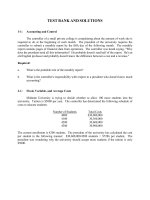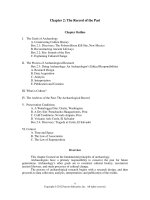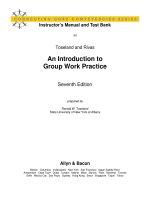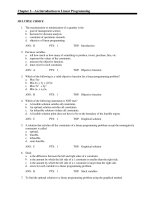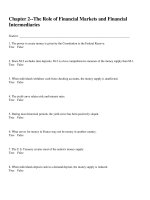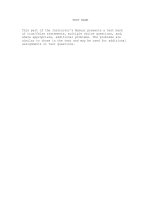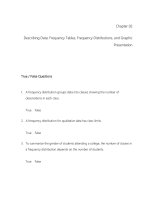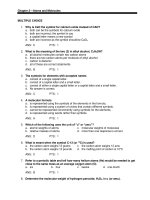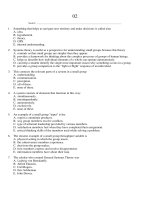Psychological testing and assessment an introduction to tests and measurement 8th edition cohen test bank
Bạn đang xem bản rút gọn của tài liệu. Xem và tải ngay bản đầy đủ của tài liệu tại đây (92.62 KB, 26 trang )
Chapter 02 - Historical, Cultural, and Legal/Ethical Considerations
Chapter 02
Historical, Cultural, and Legal/Ethical Considerations
Multiple Choice Questions
1. Just listen to the cheers in the hall the next time grades are posted outside of your
instructor's office. This is a parallel to the ancient Chinese practice of
A. celebrating the end of the academic school year.
B. screaming in pain from acupuncture.
C. "releasing the roll."
D. "unwrapping the foot."
2. In ancient Egypt, counseling and psychotherapy was MOST probably carried out by
A. physicians.
B. pharaohs.
C. priests.
D. barbers.
3. This ancient Egyptian document listed incantations to be used in warding off demons. It is
now referred to as the
A. Edwin Smyth papyrus.
B. Eddysullivan papyrus.
C. Mayer papyrus.
D. Ebers papyrus.
4. When a test must be administered with an aid of a translator,
A. subtle nuances of meaning may be "lost in translation."
B. pre-training for the translator is desirable.
C. pre-training for the assessor is desirable.
D. All of these
2-1
© 2013 by McGraw-Hill Education. This is proprietary material solely for authorized instructor use. Not authorized for sale or distribution in
any manner. This document may not be copied, scanned, duplicated, forwarded, distributed, or posted on a website, in whole or part
Chapter 02 - Historical, Cultural, and Legal/Ethical Considerations
5. In Chapter 2's Meet an Assessment Professional, Dr. Nathaniel Mohatt made reference to
the People's Awakening Project, a community-based study dealing with problems stemming
primarily from
A. domestic violence.
B. alcoholism.
C. post-traumatic stress.
D. lack of resiliency.
6. In developing the Awareness of Connectedness Scale (ACS), the test authors began with
the premise that measurement tools for assessing risk, resiliency, and change can and should
be based on cultural notions of disorder, wellness, and healing. Who authored the ACS?
A. Mohatt
B. Markus
C. Kitayama
D. Both b and c
7. In which type of culture is value placed on traits such as conformity, cooperation, and
interdependence?
A. an individualist culture
B. a collectivist culture
C. an equitable culture
D. an equitable trust culture
8. "Does a court order for a compulsory psychiatric examination of the defendant in a criminal
trial violate that defendant's fifth amendment right to avoid self-incrimination?" This was the
question before the court in the case of
A. Mitchell v. State.
B. Allen v. District of Columbia.
C. Tarasoff v. Regents of the University of California.
D. Jaffee v. Redmond.
2-2
© 2013 by McGraw-Hill Education. This is proprietary material solely for authorized instructor use. Not authorized for sale or distribution in
any manner. This document may not be copied, scanned, duplicated, forwarded, distributed, or posted on a website, in whole or part
Chapter 02 - Historical, Cultural, and Legal/Ethical Considerations
9. Which defendant argued (unsuccessfully) in his appeal that his death penalty conviction
should be set aside because he was suffering from a mental disease?
A. Tarasoff
B. Daubert
C. Zink
D. Mitchell
10. A case cited in your text recounted details of the unsuccessful appeal of a defendant's
death penalty sentence. In that case, the appeal was denied
A. because the defendant was found to be incompetent to stand trial
B. on the basis of the Frye standard.
C. on the basis of the Daubert standard.
D. All of these
11. Persons diagnosed with different psychiatric disorders may have differing capacities to
provide truly informed consent. A person suffering from which of the following disorders
would have the BEST probability of providing truly informed consent?
A. dementia
B. major depression
C. schizophrenia
D. bipolar disorder.
12. The testing program that existed in China between 1115 b.c.e. and 1905 is most similar to
which of the following today?
A. civil service testing
B. college aptitude testing
C. achievement testing
D. drug abuse testing
13. As used in the text, the term imperial examinations refers to assessment for
A. knighthood in the Middle Ages.
B. civil service in ancient China.
C. competency to stand trial in Japan.
D. gang membership in Newark, New Jersey
2-3
© 2013 by McGraw-Hill Education. This is proprietary material solely for authorized instructor use. Not authorized for sale or distribution in
any manner. This document may not be copied, scanned, duplicated, forwarded, distributed, or posted on a website, in whole or part
Chapter 02 - Historical, Cultural, and Legal/Ethical Considerations
14. As used in the text, the practice of releasing the roll refers to
A. assessment of body fat.
B. assessment of hypnotic susceptibility by measuring eye roll.
C. bribing a public official to obtain test score answers.
D. posting test scores on a wall.
15. During the Middle Ages, the focus of early "diagnostic techniques" was on identifying:
A. slow learners.
B. those who had scurvy.
C. witches.
D. competent civil service workers.
16. Which of the following positions would Galton argue in favor of?
A. Genius runs in families.
B. Environment is the most important determinant of genius.
C. Genius ruins families.
D. Darwin's theory was overstated.
17. How did the work of Wundt differ from that of Galton, Binet, and James McKeen
Cattell?
A. Wundt used standardized psychological tests.
B. Wundt utilized humans and not animal research subjects.
C. Wundt focused on how individuals were the same rather than different.
D. Wundt focused on how individuals were different rather than the same.
18. Who is credited with being the originator of the psychometric concept of test reliability?
A. Spearman
B. Pearson
C. Kraeplin
D. Tichener
2-4
© 2013 by McGraw-Hill Education. This is proprietary material solely for authorized instructor use. Not authorized for sale or distribution in
any manner. This document may not be copied, scanned, duplicated, forwarded, distributed, or posted on a website, in whole or part
Chapter 02 - Historical, Cultural, and Legal/Ethical Considerations
19. Who coined the term mental test in 1890?
A. Binet
B. b.Cattell
C. Wundt
D. Galton
20. Much of 19th-century psychological measurement focused on
A. intelligence.
B. ethics and values.
C. sensory abilities.
D. personality traits.
21. Which of the following would be LEAST likely to be used as an item on a projective test
of personality?
A. an inkblot
B. a photo of a man in a rowboat on a lake
C. a drawing of a cloud
D. a common teaspoon
22. Projective tests may be viewed as remedying a deficiency of which other type of
psychological test?
A. intelligence tests
B. proficiency tests
C. self-report tests
D. neurological tests
23. In addition to his test-related "claim to fame," this man was the first football coach at the
University of Southern California. He is, of course,
A. Robert S. Woodworth.
B. Henry H. Goddard.
C. Ovide DeCroly.
D. Lightner Witmer.
2-5
© 2013 by McGraw-Hill Education. This is proprietary material solely for authorized instructor use. Not authorized for sale or distribution in
any manner. This document may not be copied, scanned, duplicated, forwarded, distributed, or posted on a website, in whole or part
Chapter 02 - Historical, Cultural, and Legal/Ethical Considerations
24. Today, which of the following groups would be MOST likely to cite the research of Henry
H. Goddard in literature it produces for public consumption?
A. The Ku Klux Klan (KKK)
B. The American Civil Liberties Union (ACLU)
C. The American Psychological Association (APA)
D. The American Society for the Prevention of Cruelty to Animals (ASPCA)
25. Which of the following movements was MOST supported by the research published by
Henry H. Goddard?
A. the eugenics movement
B. the anti-whaling movement
C. the pro-life movement
D. the labor union movement
26. The mental ability evaluations conducted at Ellis Island could best be characterized as:
A. psychological testing.
B. psychological assessment.
C. case-study techniques.
D. interviewing.
27. Psychological test data gathered from immigrant assessees at Ellis Island by Henry
Goddard was
A. cited extensively in Goddard's best-seller Welcoming Europe's Gifted.
B. used to argue against compulsory sterilization for the "feeble-minded."
C. cited to support anti-immigration arguments and legislation.
D. analyzed to establish the incidence of feeble-mindedness worldwide.
28. The beginning of the group intelligence testing movement is best associated with
A. the need to identify slow learners in school.
B. the need to identify the best applicant for a job.
C. the military's need to screen the intellectual ability of recruits.
D. the civil service system's need to identify qualified postal workers.
2-6
© 2013 by McGraw-Hill Education. This is proprietary material solely for authorized instructor use. Not authorized for sale or distribution in
any manner. This document may not be copied, scanned, duplicated, forwarded, distributed, or posted on a website, in whole or part
Chapter 02 - Historical, Cultural, and Legal/Ethical Considerations
29. In the 1930s, clinical psychology was synonymous with:
A. personality testing.
B. mental testing.
C. vocational testing.
D. educational testing.
30. Which of the following represents a problem unique to self-report personality tests?
A. Respondents might be unwilling to reveal something negative about themselves.
B. Respondents may be too "low" on the construct being measured for the trait to register
properly on the test.
C. The reading ability of respondents may prevent them from responding accurately to items.
D. All of these
31. An approach to personality assessment that does not employ self-report methods is
referred to as
A. a reflective method.
B. a projective method.
C. a factorial method.
D. a nonempirical method.
32. History records which of the following as the first personality test to be developed after
the first world war?
A. the Bernreuter Personality Inventory
B. the Mooney Problem Checklist
C. the Personal Data Sheet
D. the MMPI
33. Henry A. Murray is the author of a "personology" theory of personality and is best
associated with which test?
A. the Rorschach Inkblot Test
B. the Thematic Apperception Test
C. the Draw-A-Person Technique
D. the Mooney Problem Checklist
2-7
© 2013 by McGraw-Hill Education. This is proprietary material solely for authorized instructor use. Not authorized for sale or distribution in
any manner. This document may not be copied, scanned, duplicated, forwarded, distributed, or posted on a website, in whole or part
Chapter 02 - Historical, Cultural, and Legal/Ethical Considerations
34. "Never shoot 'em in the back," "Do not fudge data," and "A captain goes down with his
ship" are all BEST characterized as a body of
A. laws.
B. ethics.
C. rules.
D. traditions.
35. A body of principles of "right," "proper," or "good" conduct is referred to as a body of
A. laws.
B. ethics.
C. traditions.
D. rules.
36. Which of the following terms BEST characterizes the relationship between the enterprise
of psychological testing and the public during the 20th century?
A. a love affair
B. just good friends
C. perfect strangers
D. a stormy relationship
37. Which historical event was the impetus for the awarding of federal funds to schools in an
effort to identify gifted and talented students?
A. World War I
B. World War II
C. the launch of Sputnik
D. the presidential election of 1960
38. Which of the following laws requires having an interpreter available to provide job
training or job selection testing?
A. Americans with Disabilities Act of 1990
B. English as a Second Language Act of 1992
C. The Hobson and Hansen Amendment of 1991
D. None of these
2-8
© 2013 by McGraw-Hill Education. This is proprietary material solely for authorized instructor use. Not authorized for sale or distribution in
any manner. This document may not be copied, scanned, duplicated, forwarded, distributed, or posted on a website, in whole or part
Chapter 02 - Historical, Cultural, and Legal/Ethical Considerations
39. Tests relevant primarily to white middle-class students produce inaccurate and misleading
test scores when administered to lower-class African-American students. This was the
conclusion of a court in which of the following cases?
A. Diana v. State Board of Education (1970)
B. Hobson v. Hansen (1967)
C. Larry P. v. Riles (1979)
D. Debra v. Turlington (1981)
40. In which case was it ruled that all IQ tests used for placement in special education classes
for the mentally retarded (developmentally disabled) must be administered in the language in
which the student is most fluent?
A. Diana v. State Board of Education (1970)
B. Hobson v. Hansen (1967)
C. Larry P. v. Riles (1979)
D. Smith v. School District of Montgomery County (1951)
41. In which case was it ruled that IQ tests cannot be administered to African-American
students for the purpose of placement in special education classes?
A. Diana v. State Board of Education (1970)
B. Hobson v. Hansen (1967)
C. Larry P. v. Riles (1979)
D. Smith v. Board of Education (1981)
42. In which case was it ruled that employment tests must measure the person for the specific
job for which he or she is applying?
A. Allen v. District of Columbia (1993)
B. Aderand Constructors, Inc. v.Pena et al. (1985)
C. Griggs v. Duke Power Company (1971)
D. Grutter v. Bollinger, et al. (2003)
2-9
© 2013 by McGraw-Hill Education. This is proprietary material solely for authorized instructor use. Not authorized for sale or distribution in
any manner. This document may not be copied, scanned, duplicated, forwarded, distributed, or posted on a website, in whole or part
Chapter 02 - Historical, Cultural, and Legal/Ethical Considerations
43. Griggs v. Duke Power Company and Albemarle Paper Company v. Moody had what issue
in common?
A. the use of tests that discriminate against minorities because they do not measure the
specific skills required for the job
B. the use of tests that discriminate against minorities in that they were unfairly used to
terminate employment
C. the use of tests that discriminate against minorities because examiners administering the
tests were biased
D. the use of tests that discriminate against minorities because the test data were used unfairly
to determine promotions
44. In which court case did the court find that minimum competency testing in the State of
Florida perpetuated the effects of past discrimination?
A. Diana v. State Board of Education (1970)
B. Hobson v. Hansen (1967)
C. Larry P. v. Riles (1979)
D. Debra v. Turlington (1981)
45. What publication presents standards for constructing and using fair and nondiscriminative employment tests?
A. Ethical Standards of Psychologists
B. Guidelinesfor Fair and Nondiscriminative Employment Testing
C. Uniform Guidelines on Employee Selection Procedures
D. SpecialtyGuidelines in Administering and Interpreting Employment Tests
46. Public concern about various aspects of psychological testing reached a peak in
A. the 1940s.
B. the 1950s.
C. the 1960s.
D. the 1970s.
2-10
© 2013 by McGraw-Hill Education. This is proprietary material solely for authorized instructor use. Not authorized for sale or distribution in
any manner. This document may not be copied, scanned, duplicated, forwarded, distributed, or posted on a website, in whole or part
Chapter 02 - Historical, Cultural, and Legal/Ethical Considerations
47. The Family Rights and Privacy Act mandated that
A. parents and students have an opportunity to review their school records.
B. all children have a right to attend private schools with public funds.
C. parents and students have no right to challenge the content of school records.
D. families who are victims of identity theft are eligible for special grants
48. "Truth in testing" laws relate to tests typically administered in
A. elementary and secondary school.
B. nursery school.
C. postsecondary and professional school.
D. hair, makeup, and cosmetology academies.
49. Which of the following is a key provision in "truth in testing" legislation?
A. Only tests approved by APA may be published.
B. Answers keyed "correct" must indeed be correct.
C. Two proofs of identification are required to sit for federal examinations.
D. Test questions and answers must be revealed to all test-takers.
50. Tests are categorized as
A. level 1, 2, or 3, depending on how difficult it is to administer the test.
B. level A, B, and C, depending on how much testing-related knowledge is necessary to
administer the test.
C. level alpha, beta, or gamma, depending on how many years of education are required by
testtakers to be admitted for testing.
D. "thumbs up" or "thumbs down" by the APA Council on Testing.
51. According to the Standards for Educational and Psychological Tests and Manuals, the
responsibility for the use of psychological tests is that of
A. professionals with the highest academic degree in psychology.
B. professionals with the necessary training and experience.
C. professionals who have state certification to administer a particular test.
D. professionals who have received online certification in test administration
2-11
© 2013 by McGraw-Hill Education. This is proprietary material solely for authorized instructor use. Not authorized for sale or distribution in
any manner. This document may not be copied, scanned, duplicated, forwarded, distributed, or posted on a website, in whole or part
Chapter 02 - Historical, Cultural, and Legal/Ethical Considerations
52. The Code of Fair Testing Practices in Education was developed and endorsed by
A. test publishers.
B. professional organizations.
C. Congress.
D. Both a and b
53. What assumption can reasonably be made when a well-known, well-respected, and widely
used test is translated from English into another language?
A. The test will likely become well known, well respected, and widely used in all of the
countries throughout the world that speak the language into which the test was translated.
B. The test will be equivalent in content in all of the languages for which it has been
translated.
C. The translated test should sell well in Columbia.
D. None of these
54. Which of the following statements is NOT true about Henry Goddard?
A. He raised questions about how meaningful intelligence tests were for people of diverse
backgrounds.
B. He used intelligence test data to argue against capital punishment for the "feebleminded."
C. He advocated for the institutionalization or sterilization of the mentally retarded to prevent
future generations from having low intelligence.
D. He developed a culturally sensitive intelligence test that measured culturally specific
aspects of intelligence common to East Asian immigrants.
55. A client tells his psychologist that he is planning to kill his girlfriend. The psychologist
has reason to believe that the client will act on this plan. In this situation, the psychologist has
a duty to:
A. keep the information privileged and address the problem in therapy.
B. keep the information confidential and address the problem in therapy.
C. warn the endangered third party or call the police.
D. contact the client for an emergency session to explore the issues further.
2-12
© 2013 by McGraw-Hill Education. This is proprietary material solely for authorized instructor use. Not authorized for sale or distribution in
any manner. This document may not be copied, scanned, duplicated, forwarded, distributed, or posted on a website, in whole or part
Chapter 02 - Historical, Cultural, and Legal/Ethical Considerations
56. In general, testtakers have the right
A. to know why they are being tested.
B. to know the results of the test they took.
C. to know how the test data will be used.
D. All of these
57. The "privilege" referred to in the term privileged communication belongs to
A. the test developer.
B. the test user.
C. the testtaker.
D. the test publisher.
58. Regarding psychologists' duty to warn in cases involving testtakers who are HIVpositive,
A. most states have enacted legislation to protect mental health professionals from liability for
"good faith" disclosure to an at-risk third party.
B. the issue has yet to be addressed by any courts or legislature.
C. most states have enacted legislation that provides limits to confidentiality of one's HIVpositive diagnosis.
D. the issue was historically first addressed by the Idaho State Legislature.
59. The matter of having test findings held confidential by psychologists is
A. a matter of professional ethics.
B. a right upheld by case law.
C. a right cited in legislation.
D. All of these
2-13
© 2013 by McGraw-Hill Education. This is proprietary material solely for authorized instructor use. Not authorized for sale or distribution in
any manner. This document may not be copied, scanned, duplicated, forwarded, distributed, or posted on a website, in whole or part
Chapter 02 - Historical, Cultural, and Legal/Ethical Considerations
60. Which is TRUE of Oregon's Death with Dignity Act?
A. Relatives of the patient must arrange a consultation with an Oregon-licensed psychologist
or psychiatrist who must be available to consult with the family for a one-year period
subsequent to the patient's demise.
B. The patient must have less than a year to live to be covered by this Act.
C. A psychologist or psychiatrist may be requested to evaluate the patient for impaired
judgment and the presence of psychopathology.
D. All of these
61. A psychologist licensed in Oregon may not accept a referral to evaluate a dying patient
under the provisions of Oregon's Death with Dignity Act
A. in accordance with an ethical obligation to prevent suicide.
B. if that psychologist had previously treated the dying patient for any psychosis.
C. if the dying patient is a member of the psychologist's family.
D. All of these
62. In the psychological assessment of a dying patient in Oregon who is requesting "death
with dignity" assistance, the role of the assessor is to evaluate the dying patient's
A. family support system.
B. competency to make a life-ending decision.
C. level and sensitivity to pain.
D. All of these
63. For over 3,000 years, open and competitive examinations were administered in China.
What these examinations measured could BEST be described as
A. integrity.
B. personality.
C. motivation.
D. proficiency.
2-14
© 2013 by McGraw-Hill Education. This is proprietary material solely for authorized instructor use. Not authorized for sale or distribution in
any manner. This document may not be copied, scanned, duplicated, forwarded, distributed, or posted on a website, in whole or part
Chapter 02 - Historical, Cultural, and Legal/Ethical Considerations
64. Which behavioral scientist viewed individual differences as a source of error in
experimentation?
A. Cattell
B. Darwin
C. Wundt
D. Witmer
65. Who coined the term "mental test"?
A. Alfred Binet
B. James Cattell
C. Victor Henri
D. Charles Spearman
66. During World War I, Robert Woodsworth and his committee developed a measure of
A. intelligence
B. emotional stability.
C. conscientious objection
D. patriotism
67. An intelligence test originally written in English is to be administered to a group of
Japanese immigrants who do not speak English. In order to obtain an accurate measure of
intelligence and attempt to eliminate any possible effects due to language, the test
administrator should
A. have a professional translator read the test to the group, simultaneously translating the
items word-for-word.
B. have a friend or family member of the group who is fluent in English and Japanese read the
test to the group, simultaneously translating the items word-for-word.
C. have a teacher fluent in Japanese and English conduct a brief tutorial in English prior to
administering the test in English, with specific attention given to the meaning of the wording
of key items and corresponding responses.
D. None of these
2-15
© 2013 by McGraw-Hill Education. This is proprietary material solely for authorized instructor use. Not authorized for sale or distribution in
any manner. This document may not be copied, scanned, duplicated, forwarded, distributed, or posted on a website, in whole or part
Chapter 02 - Historical, Cultural, and Legal/Ethical Considerations
68. Which of the following is the term used for a variant of a language that has its own rules
of structure, meaning, and pronunciation?
A. parallel language
B. alternate language
C. spoken dialect
D. regional accent
69. Nonverbal communication or "body language" does not
A. exist in all cultures.
B. impact the perceptions of others.
C. convey the same meaning across cultures.
D. have any significance on the VH1 series, Mob Wives.
70. Sigmund Freud believed that nonverbal behaviors provide clues regarding
A. intelligence.
B. achievement.
C. ethnicity.
D. motivation.
71. Which organization published Technical Recommendations for Psychological and
Diagnostic Tests?
A. the American Psychological Association
B. the American Educational Research Association
C. the National Council on Measurement in Education
D. the Council for Exceptional Children
72. Consistent with recommendations regarding professional ethics, post-test feedback to
testtakers
A. must avoid any information that may arouse anxiety.
B. should focus on only "positive" findings.
C. should be accurate and understandable.
D. will always use diagnostic labels sparingly.
2-16
© 2013 by McGraw-Hill Education. This is proprietary material solely for authorized instructor use. Not authorized for sale or distribution in
any manner. This document may not be copied, scanned, duplicated, forwarded, distributed, or posted on a website, in whole or part
Chapter 02 - Historical, Cultural, and Legal/Ethical Considerations
73. As mentioned in your text, which of the following is a means of safeguarding test
records?
A. storing test records in a locked filing cabinet
B. only allowing security officials to have computer passwords
C. installing and maintaining a special alarm system in the record storage room
D. storing records at an external storage facility away from the office
74. One of the consequences of the Health Insurance Portability and Accountability Act of
1996 (HIPAA) is that
A. clients are now able to sue mental health professionals for over-charging
B. psychotherapy notes require more stringent protection than other types of records.
C. mental health professionals may not bill for completing insurance paperwork.
D. service providers must provide confidential information to health insurance companies.
75. The fact that employment testing materials and procedures must be essential to the job and
not discriminate against persons with disabilities is attributable to which legislation?
A. Americans with Disabilities Act of 1990
B. Civil Rights Act of 1964
C. Family Education Rights and Privacy Act of 1974
D. Education for All Handicapped Children Act of 1975
76. Which legislation provided that all children with suspected mental or physical disabilities
must be evaluated periodically by a team of professionals?
A. Americans with Disabilities Act of 1990
B. Civil Rights Act of 1964
C. Family Education Rights and Privacy Act of 1974
D. Education for All Handicapped Children Act of 1975
77. Which legislation provided that parents and eligible students be given access to school
records?
A. Americans with Disabilities Act of 1990
B. Civil Rights Act of 1964
C. Family Education Rights and Privacy Act of 1974
D. Education for All Handicapped Children Act of 1975
2-17
© 2013 by McGraw-Hill Education. This is proprietary material solely for authorized instructor use. Not authorized for sale or distribution in
any manner. This document may not be copied, scanned, duplicated, forwarded, distributed, or posted on a website, in whole or part
Chapter 02 - Historical, Cultural, and Legal/Ethical Considerations
78. Which legislation provided that employers, when making employment decisions with
ability tests, cannot use different cutoff scores on the basis of race, religion, sex, or national
origin?
A. Americans with Disabilities Act of 1990
B. Civil Rights Act of 1964
C. Family Education Rights and Privacy Act of 1974
D. Education for All Handicapped Children Act of 1975
79. Which legislation modified privacy standards thus restricting the way that mental health
providers can use patients' personal information?
A. Americans with Disabilities Act of 1990
B. Individuals with Disabilities Education Act of 1997
C. Family Education Rights and Privacy Act of 1974
D. Health Insurance Portability and Accountability Act of 1996
80. Ability tests developed using samples of White testtakers cannot be used to track AfricanAmerican students in the school system. This was the essence of the ruling in which of the
following court cases?
A. Hobson v. Hanson (1967)
B. Larry P. v. Riles (1979)
C. Debra P. v. Turlington (1981)
D. Griggs v. Duke Power Company (1971)
81. Which court case resulted in the ruling that intelligence tests could not be used to place
African-American children in special classes in California?
A. Hobson v. Hanson (1967)
B. Larry P. v. Riles (1979)
C. Debra P. v. Turlington (1981)
D. Griggs v. Duke Power Company (1971)
2-18
© 2013 by McGraw-Hill Education. This is proprietary material solely for authorized instructor use. Not authorized for sale or distribution in
any manner. This document may not be copied, scanned, duplicated, forwarded, distributed, or posted on a website, in whole or part
Chapter 02 - Historical, Cultural, and Legal/Ethical Considerations
82. A general ability test predicted job performance but was found to be discriminatory
because Whites scored better on it on average than African-Americans. This is a reference to
which of the following court cases?
A. Adarand Constructors, Inc. v. Pena et al. (1995)
B. Jafee v. Redmond (1996)
C. Griggs v. Duke Power Company (1971)
D. AlbemarlePaper Company v. Moody (1976)
83. Which court case culminated in a ruling that a city fire department could use a test of
specific firefighting abilities to make promotion decisions even if Whites tended to outscore
African-American firefighters?
A. Allen v. District of Columbia (1993)
B. Adarand Constructors, Inc. v. Pena et al. (1995)
C. Regents of the University of California v. Bakke (1978)
D. Jaffee v. Redmond (1996)
84. Which court case resulted in the ruling that the federal government cannot apply
affirmative action principles in awarding federal contracts to companies unless there is a
compelling reason to do so?
A. Allen v. District of Columbia (1993)
B. Adarand Constructors, Inc. v. Pena et al. (1995)
C. Regents of the University of California v. Bakke (1978)
D. Jaffee v. Redmond (1996)
85. Which court case resulted in the ruling for the first time that diversity considerations can
be used in university admissions decisions?
A. Allen v. District of Columbia (1993)
B. Regents of the University of California v. Bakke (1978)
C. Chan v. Yale University (1996)
D. Tarasoff v. Regents of the University of California (1974)
2-19
© 2013 by McGraw-Hill Education. This is proprietary material solely for authorized instructor use. Not authorized for sale or distribution in
any manner. This document may not be copied, scanned, duplicated, forwarded, distributed, or posted on a website, in whole or part
Chapter 02 - Historical, Cultural, and Legal/Ethical Considerations
86. Which court case resulted in the ruling that the communication between a psychotherapist
and a patient is privileged in federal courts?
A. Allen v. District of Columbia (1993)
B. Adarand Constructors, Inc. v. Pena et al. (1995)
C. Regents of the University of California v. Bakke (1978)
D. Jaffee v. Redmond (1996)
87. Which court case resulted in the ruling that psychotherapists must reveal privileged
information if a third party is endangered?
A. Allen v. District of Columbia (1993)
B. Regents of the University of California v. Bakke (1978)
C. Jaffee v. Redmond (1996)
D. Tarasoff v. Regents of the University of California (1974)
88. Which court case reaffirmed the rights of universities to use race in admissions decisions
to further the educational benefits that flow from a diverse student body?
A. Allen v. District of Columbia (1993)
B. Malcolm v. Las Vegas Technical School (2008)
C. Grutter v. Bollinger (2003)
D. Jaffee v. Redmond (1996)
89. A psychologist who does not act in the same or similar way that other reasonable
psychologists would have acted under the same or similar circumstances may be found liable
for
A. incompetency.
B. negligence.
C. abuse.
D. malpractice.
2-20
© 2013 by McGraw-Hill Education. This is proprietary material solely for authorized instructor use. Not authorized for sale or distribution in
any manner. This document may not be copied, scanned, duplicated, forwarded, distributed, or posted on a website, in whole or part
Chapter 02 - Historical, Cultural, and Legal/Ethical Considerations
90. In the everyday practice of psychological assessment, how do questions and issues about a
test-taker's proficiency in the English language typically get resolved?
A. by a determination based on the number of years of formal education in English
B. by the score achieved on a test of English as a Second Language
C. on a case-by-case basis
D. informal evaluation of comprehension of "knock-knock" jokes
91. Many testtaker characteristics are affected by culture including
A. a testtaker's expressive communication skills
B. a testtaker's nonverbal communication
C. a testtaker's receptive communication skills
D. All of these
92. With regard to litigation involving hiring and promotion, it is a fact that
A. tests that yield scores that systematically show differences by racial group cannot be used
for any purpose.
B. local, state, and federal courts are in agreement as to which psychological tests may and
may not be used.
C. only tests shown to predict job success may be used.
D. None of these
93. "Psychologists must use only those techniques for which they are qualified by education,
training, and experience." This quote was MOST likely taken from the pages of
A. the decision in Tarasoff v. Regents of the University of California (1974)
B. Ethical Principles of Psychologists.
C. Tests in Print.
D. the Oregon Death with Dignity statute.
2-21
© 2013 by McGraw-Hill Education. This is proprietary material solely for authorized instructor use. Not authorized for sale or distribution in
any manner. This document may not be copied, scanned, duplicated, forwarded, distributed, or posted on a website, in whole or part
Chapter 02 - Historical, Cultural, and Legal/Ethical Considerations
94. Which is the BEST example of malpractice by a psychologist?
A. A psychologist misdiagnosed a client
B. A psychologist acted in a significantly different way as compared to the way that other
psychologists would have acted under the same or similar circumstances.
C. A psychologist who did not hold a doctoral degree administered and interpreted tests while
employed as a school psychologist.
D. A psychologist learned about why certain psychological tests were administered by
watching re-runs of Dr. Phil.
95. Which of the following is the MOST important reason why translating a test into another
language is not recommended?
A. It can be extremely costly.
B. It can be extremely time-consuming.
C. Meanings of the items may change.
D. Translation must conform to the specific dialect of the test-taker.
96. To ensure that a test developed for national use is indeed suitable for national use, test
developers
A. employ a culturally representative group of examiners.
B. have a culturally representative panel of experts review test items.
C. post sample items on the Web to gauge response of different groups.
D. All of these
97. Sir Francis Galton measured each of the following EXCEPT
A. the mental ability of humans.
B. genetic inheritance in sweet peas.
C. the standing height of humans.
D. the sitting height of humans.
2-22
© 2013 by McGraw-Hill Education. This is proprietary material solely for authorized instructor use. Not authorized for sale or distribution in
any manner. This document may not be copied, scanned, duplicated, forwarded, distributed, or posted on a website, in whole or part
Chapter 02 - Historical, Cultural, and Legal/Ethical Considerations
98. Legal and ethical mandates regarding vocational assessment require that performance on
vocational tests measure
A. important cultural factors.
B. job-related abilities.
C. unobtrusive variables.
D. All of these
99. Ultimately, which of the following parties to the assessment enterprise provides the
guidance for determining what constitutes the fair use of tests in the hiring process?
A. test publishers
B. test users
C. society at large
D. test-takers
100. The Daubert case had implications for the role of
A. psychologists with respect to admitting patients to mental hospitals.
B. judges with respect to admitting expert testimony into evidence.
C. test publishers with respect to hiring test developers.
D. All of these
101. The origins of Daubert v. Merrell Dow Pharmaceuticals can be traced to
A. Mrs. Daubert taking a prescription drug to relieve nausea.
B. Henry Daubert being denied a prescription drug by Medicare.
C. Mrs. Daubert using what turned out to be a faulty birth control device.
D. Henry Daubert suffering for five hours after taking prescription Viagra.
102. In the case of Daubert v. Merrell Dow Pharmaceuticals, the plaintiff (Daubert)
A. did not win the case at the original trial.
B. did not win the case on appeal.
C. first won the case at the level of the Supreme Court.
D. All of these
2-23
© 2013 by McGraw-Hill Education. This is proprietary material solely for authorized instructor use. Not authorized for sale or distribution in
any manner. This document may not be copied, scanned, duplicated, forwarded, distributed, or posted on a website, in whole or part
Chapter 02 - Historical, Cultural, and Legal/Ethical Considerations
103. In the 1923 case of Frye v. United States, the Court held that scientific research is
admissible into evidence
A. at the sole discretion of the Court.
B. only when successfully challenged by a competent second expert.
C. when the research enjoys general acceptance.
D. if the research was based on a scholarly review of the literature.
104. The significance of Daubert v. Merrell Dow Pharmaceuticals is that
A. trial judges were given wider discretion in terms of what shall be admitted into evidence.
B. trial judges were given a "gatekeeping" function.
C. trial judges could admit into evidence scientific testimony that had not yet won general
acceptance in the scientific community.
D. All of these
105. From the intelligence test data he gathered at Ellis Island, Henry Goddard concluded that
many of the people attempting to immigrate to the United States were "feebleminded." This
conclusion was
A. entirely justified as shown in subsequent research by Lewis Terman.
B. largely the result of using a test that overestimated mental deficiency.
C. probably an exaggeration due to Goddard's known prejudice.
D. in keeping with the culture of the day which focused on nurture over nature.
106. Laws are rules of conduct that derive from a society's
A. legislatures.
B. courts.
C. code of ethics
D. Both a and b
2-24
© 2013 by McGraw-Hill Education. This is proprietary material solely for authorized instructor use. Not authorized for sale or distribution in
any manner. This document may not be copied, scanned, duplicated, forwarded, distributed, or posted on a website, in whole or part
Chapter 02 - Historical, Cultural, and Legal/Ethical Considerations
107. Taken together, the cases of PARC v. Commonwealth of Pennsylvania (1971, 1972), and
Mills v. Board of Education of District of Columbia (1972) illustrate
A. why psychological tests must be used responsibly.
B. how litigation can lead to legislation.
C. judicial enforcement of the right to privacy.
D. why public parks are ideally within walking distance from public schools
2-25
© 2013 by McGraw-Hill Education. This is proprietary material solely for authorized instructor use. Not authorized for sale or distribution in
any manner. This document may not be copied, scanned, duplicated, forwarded, distributed, or posted on a website, in whole or part
